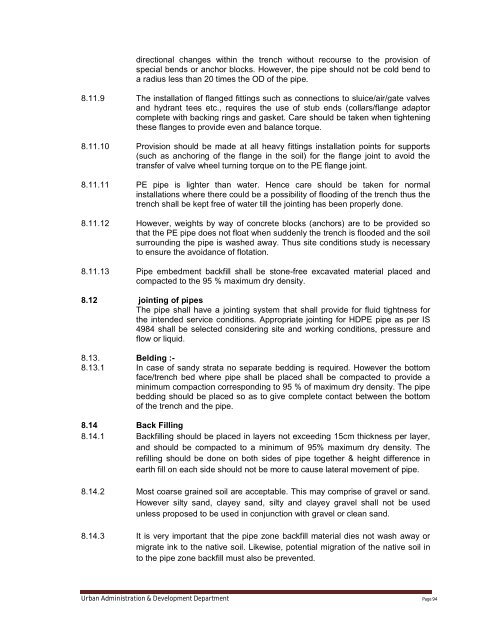Specifications Part 1 - Water Supply, Sewerage and Tube Well Works
Specifications Part 1 - Water Supply, Sewerage and Tube Well Works
Specifications Part 1 - Water Supply, Sewerage and Tube Well Works
You also want an ePaper? Increase the reach of your titles
YUMPU automatically turns print PDFs into web optimized ePapers that Google loves.
directional changes within the trench without recourse to the provision ofspecial bends or anchor blocks. However, the pipe should not be cold bend toa radius less than 20 times the OD of the pipe.8.11.9 The installation of flanged fittings such as connections to sluice/air/gate valves<strong>and</strong> hydrant tees etc., requires the use of stub ends (collars/flange adaptorcomplete with backing rings <strong>and</strong> gasket. Care should be taken when tighteningthese flanges to provide even <strong>and</strong> balance torque.8.11.10 Provision should be made at all heavy fittings installation points for supports(such as anchoring of the flange in the soil) for the flange joint to avoid thetransfer of valve wheel turning torque on to the PE flange joint.8.11.11 PE pipe is lighter than water. Hence care should be taken for normalinstallations where there could be a possibility of flooding of the trench thus thetrench shall be kept free of water till the jointing has been properly done.8.11.12 However, weights by way of concrete blocks (anchors) are to be provided sothat the PE pipe does not float when suddenly the trench is flooded <strong>and</strong> the soilsurrounding the pipe is washed away. Thus site conditions study is necessaryto ensure the avoidance of flotation.8.11.13 Pipe embedment backfill shall be stone-free excavated material placed <strong>and</strong>compacted to the 95 % maximum dry density.8.12 jointing of pipesThe pipe shall have a jointing system that shall provide for fluid tightness forthe intended service conditions. Appropriate jointing for HDPE pipe as per IS4984 shall be selected considering site <strong>and</strong> working conditions, pressure <strong>and</strong>flow or liquid.8.13. Belding :-8.13.1 In case of s<strong>and</strong>y strata no separate bedding is required. However the bottomface/trench bed where pipe shall be placed shall be compacted to provide aminimum compaction corresponding to 95 % of maximum dry density. The pipebedding should be placed so as to give complete contact between the bottomof the trench <strong>and</strong> the pipe.8.14 Back Filling8.14.1 Backfilling should be placed in layers not exceeding 15cm thickness per layer,<strong>and</strong> should be compacted to a minimum of 95% maximum dry density. Therefilling should be done on both sides of pipe together & height difference inearth fill on each side should not be more to cause lateral movement of pipe.8.14.2 Most coarse grained soil are acceptable. This may comprise of gravel or s<strong>and</strong>.However silty s<strong>and</strong>, clayey s<strong>and</strong>, silty <strong>and</strong> clayey gravel shall not be usedunless proposed to be used in conjunction with gravel or clean s<strong>and</strong>.8.14.3 It is very important that the pipe zone backfill material dies not wash away ormigrate ink to the native soil. Likewise, potential migration of the native soil into the pipe zone backfill must also be prevented.Urban Administration & Development Department Page 94
















